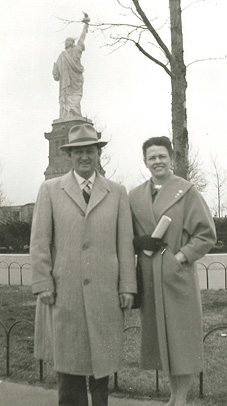 Marion and Margaret in New York City—Fall, 1956 Marion and Margaret in New York City—Fall, 1956
Marion and Margaret Bonner at the Statue of Liberty during their New York trip to the Society of Vertebrate Paleontology Meetings. |
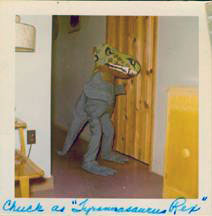 Chuck as T-Rex—1958 Chuck as T-Rex—1958
Chuck Bonner in a Tyrannosaurus rex Halloween costume made for him by his mother. |
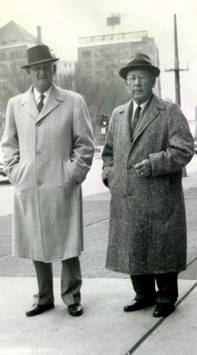 Marion and George at S.V.P.—1958 Marion and George at S.V.P.—1958
Marion Bonner and George Sternberg in Chicago for the Society of Vertebrate Paleontology meetings. |
Dana and Chuck Bonner—April, 1959
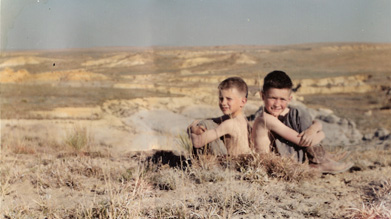 The boys in the beds. The boys in the beds.
|
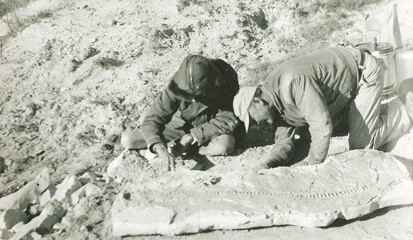 Collecting a Fossil Fish—1959 Collecting a Fossil Fish—1959
Orville and Marion Bonner preparing a slab for casting. Fall, 1959. |
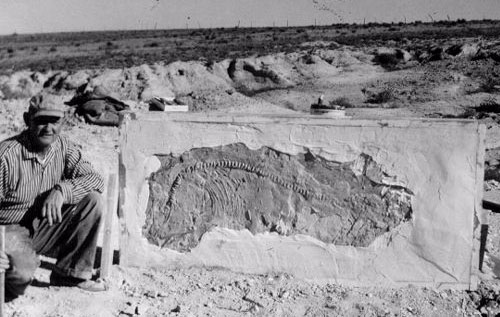 Marion with the collected fish. This Pentanogmius fish is now at the Sternberg Museum of Natural History. Marion with the collected fish. This Pentanogmius fish is now at the Sternberg Museum of Natural History. |
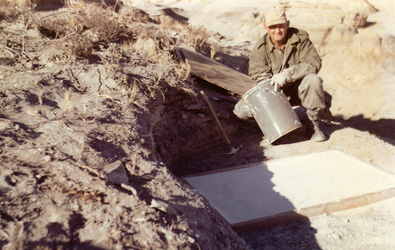 Collecting a Shark—1960 Collecting a Shark—1960
Marion collecting a shark using the plaster slab method. The specimen is now in the Field Museum of Natural History in Chicago, Illinois. |
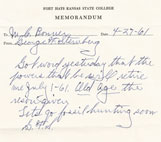 George Sternberg Letter—1961 George Sternberg Letter—1961
This note expresses George's disappointment at being retired by the college.
Click on the image for a better look and transcript. |
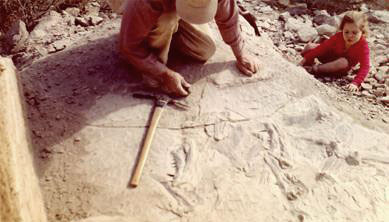 Fossil Hunting—1961 Fossil Hunting—1961
Marion Bonner working on a Xiphactinus skull with his daughter, Melanie. |
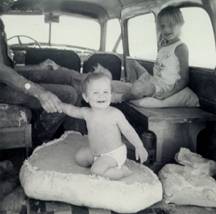 Vincent Bonner in Spiker—1965 Vincent Bonner in Spiker—1965
Vincent Bonner (son of Orville Bonner) and Melanie Bonner in the back of “Spiker,” a 1949 Chevy Suburban fossil wagon. |
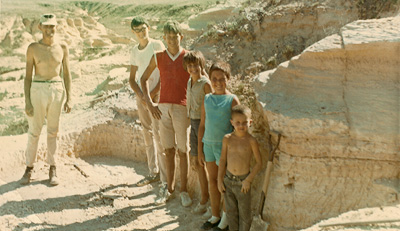 Collecting a Complete Mosasaur—Summer, 1967 Collecting a Complete Mosasaur—Summer, 1967
Orville, Chuck, Dana, and Melanie Bonner with Kari and Travis Askey, (Clare Jane Bonner’s children) at the large quarry site of a near perfect Platecarpus mosasaur now in the Natural History Museum of Los Angeles County. |
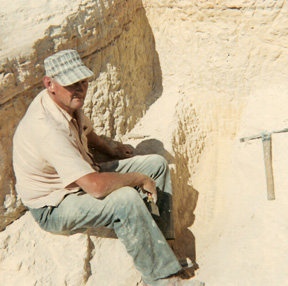 Marion Bonner deep in the mosasaur quarry. The digging was therapy for Marion as this was soon after his wife, Margaret, had passed away. Marion Bonner deep in the mosasaur quarry. The digging was therapy for Marion as this was soon after his wife, Margaret, had passed away. |
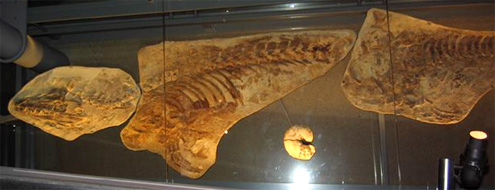 This mosasaur turned out to be the most complete Platecarpus ever collected. Exhibited in the NHM Dinosaur Hall in the original field jackets, the specimen reveals traces of a partial body outline, skin color markings, external scales, branching bronchial tubes, and evidence of the animal’s last meal from 85 million years ago—a fossil fish. This specimen had been in museum storage since 1967. This mosasaur turned out to be the most complete Platecarpus ever collected. Exhibited in the NHM Dinosaur Hall in the original field jackets, the specimen reveals traces of a partial body outline, skin color markings, external scales, branching bronchial tubes, and evidence of the animal’s last meal from 85 million years ago—a fossil fish. This specimen had been in museum storage since 1967. |
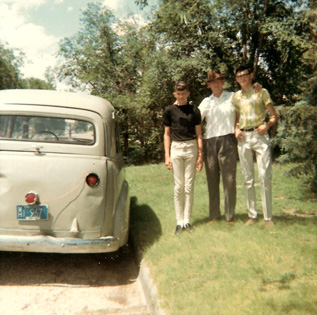 “Spiker” Fossil Delivery—1967 “Spiker” Fossil Delivery—1967
Dana, Marion and Chuck Bonner getting ready to take “Spiker” to deliver fossils to the Denver Natural History Museum. |
Bonnerichthys gladius—1972
In 2010, the Bonner family was honored by having a new fish genus named for them. The fossil, Bonnerichthys gladius was the largest fish of the Kansas Niobrara Sea. It was a huge filter feeder, much like a present day basking shark, that reached lengths of over twenty feet. Many pectoral (front) fins have been found over the years, but since it had a notochord, no vertebrae are preserved. The fish was always classified as a Protosphyraena or snout fish because of the similarity of fin shape.
The fossil was housed in the University of Kansas Museum for almost 40 years until a researcher, Matt Friedman, established a link between Jurassic filter feeder fish and this specimen. These types of fish had never been found in Cretaceous chalk deposits. The skull and fins are nearly identical and the length of the fish can be determined by comparing the size of the pectoral fins of the Jurassic specimens to the Kansas Cretaceous fish.
On a summer break from Fort Hays State in August of 1971, Chuck Bonner went on a fossil hunt with his brother Dana and father Marion. While hunting some high bluffs, the brothers both made fossil finds. Dana found the remains of a nice small turtle and Chuck found a large fish fin sticking out of the chalk. Having run out of time for the day, Marion returned at a later date to work on collecting the two specimens.
The collection of the fossil proved to be problematic: It was located on a high bluff and Marion had to carve out a place to work. While working on the fish, Marion uncovered odd parts that he was unfamiliar with—even after years of experience collecting Kansas chalk fossils. After stabilizing the piece in plaster, it had to be lowered by ropes and loaded into “Spiker,” the 1949 Chevy Suburban. The rough drive out of the canyon even broke one of Spiker’s springs!

Marion Bonner poses at the fossil fish quarry site.
|
This overhead shot of the quarry site shows large fin and skull parts. |

This long-distance shot shows Marion standing on the bluff with the fossil.
|
|



